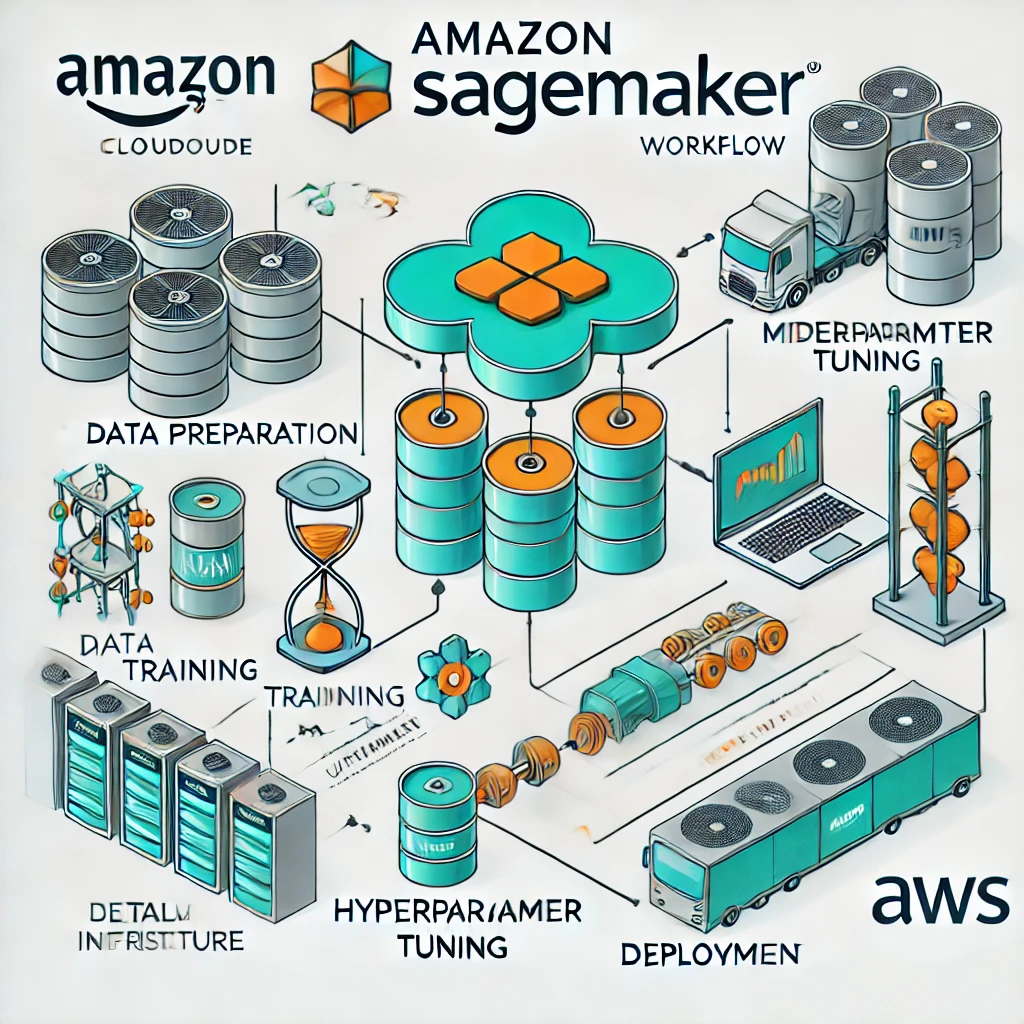Amazon SageMaker - Accelerating Machine Learning in the Cloud

Amazon SageMaker is a fully managed machine learning (ML) service from AWS that enables data scientists and developers to build, train, and deploy ML models quickly and efficiently. It eliminates the heavy lifting involved in setting up infrastructure, allowing organizations to focus on innovation. With a suite of tools for data preparation, model development, and governance, SageMaker provides an end-to-end ML workflow tailored for scalability and ease of use.
Why Use Amazon SageMaker?
Traditionally, developing ML models requires extensive infrastructure setup, large-scale data processing capabilities, and efficient deployment mechanisms. SageMaker addresses these challenges by offering an end-to-end service that streamlines the ML workflow. Here are some key benefits:
- Scalability: SageMaker allows users to train models on distributed computing resources, making it easier to handle large datasets.
- Cost-Effectiveness: With built-in auto-scaling and pay-as-you-go pricing, organizations can optimize costs.
- Ease of Use: SageMaker provides pre-built algorithms, Jupyter notebooks, and automated model tuning to accelerate development.
- Seamless Integration: It integrates with AWS services like S3, Lambda, Step Functions, and more, making it highly extensible.
- Robust Governance: SageMaker includes governance features to ensure compliance, security, and auditability.
Key Features of Amazon SageMaker
1. SageMaker Studio
Amazon SageMaker Studio is an integrated development environment (IDE) that provides a single interface for building, training, tuning, and deploying models. It offers:
- A fully managed Jupyter notebook environment
- Experiment tracking and model lineage
- Easy debugging and collaboration
2. Data Tools: SageMaker Data Wrangler and Feature Store
Data preprocessing and feature engineering are critical steps in the ML pipeline. SageMaker provides tools to simplify these tasks:
- SageMaker Data Wrangler: Allows users to import, clean, and transform data from multiple sources with built-in visualizations and automation.
- SageMaker Feature Store: A centralized repository for storing, retrieving, and sharing machine learning features across teams.
3. Models and Human Interaction
SageMaker enhances collaboration between models and human decision-makers:
- Augmented AI (A2I): Allows human review of ML model predictions for tasks like content moderation and document processing.
- SageMaker Canvas: A no-code tool that allows business analysts to build ML models without writing any code.
4. Model Training and AutoML
SageMaker provides multiple ways to train ML models:
- Built-in Algorithms: SageMaker includes optimized implementations of common algorithms for classification, regression, clustering, and more.
- Bring Your Own Algorithm (BYOA): Users can package and train custom models using TensorFlow, PyTorch, MXNet, and other frameworks.
- SageMaker Autopilot: AutoML capabilities automatically train and tune models with minimal human intervention.
5. Hyperparameter Tuning
Finding the best set of hyperparameters can be challenging. SageMaker’s automatic hyperparameter tuning helps by:
- Running multiple training jobs with different parameter configurations
- Using Bayesian optimization to find the best-performing model
- Reducing training time and improving model accuracy
6. Governance and Compliance
With increasing regulations around AI, governance is crucial. SageMaker provides governance tools to:
- Enforce Security Policies: Through role-based access controls (RBAC) and encryption.
- Track Model Lineage: Maintain versioning, audit trails, and documentation.
- Monitor Bias and Explainability: Using SageMaker Clarify to ensure fairness and transparency.
7. Model Deployment with SageMaker Inference
Once a model is trained, SageMaker provides multiple deployment options:
- Real-time Inference: Deploy models as scalable API endpoints with auto-scaling support.
- Batch Transform: Process large datasets asynchronously for offline inference.
- Edge Deployment with SageMaker Edge: Optimize and deploy models to edge devices for low-latency predictions.
8. Model Monitoring and Explainability
SageMaker provides tools to ensure ML models remain effective in production:
- SageMaker Model Monitor: Detects data drift and quality degradation.
- SageMaker Clarify: Identifies bias in models and improves interpretability.
9. SageMaker Consoles
AWS offers multiple interfaces to interact with SageMaker:
- AWS Management Console: A web-based UI for accessing SageMaker features.
- SageMaker Studio: Provides an interactive environment for end-to-end ML development.
- AWS SDK & CLI: For programmatic access and automation of ML workflows.
Use Cases of Amazon SageMaker
SageMaker is widely used across various industries for different ML applications, including:
- Financial Services: Fraud detection, credit risk modeling, and algorithmic trading.
- Healthcare: Disease prediction, medical image analysis, and genomics research.
- Retail: Personalized recommendations, demand forecasting, and inventory optimization.
- Manufacturing: Predictive maintenance, quality control, and anomaly detection.
Getting Started with Amazon SageMaker
- Set Up AWS Environment: Create an AWS account and navigate to the SageMaker console.
- Prepare Data: Store datasets in Amazon S3 and preprocess them using SageMaker Data Wrangler.
- Train a Model: Use built-in algorithms or custom training scripts to train models on SageMaker instances.
- Evaluate and Tune: Use SageMaker’s tuning features to improve model accuracy.
- Deploy for Inference: Choose a deployment method (real-time, batch, or edge) based on your application needs.
- Monitor and Optimize: Continuously track model performance using SageMaker Model Monitor.
Conclusion
Amazon SageMaker revolutionizes the ML development process by providing a comprehensive suite of tools for building, training, and deploying models at scale. Whether you’re an ML novice or an experienced data scientist, SageMaker simplifies the workflow, allowing you to focus on model innovation rather than infrastructure management. Its governance, data tools, human interaction capabilities, and flexible console interfaces make it a go-to choice for organizations aiming to scale their AI initiatives effectively.
Are you using Amazon SageMaker in your ML projects? Share your experiences in the comments below!